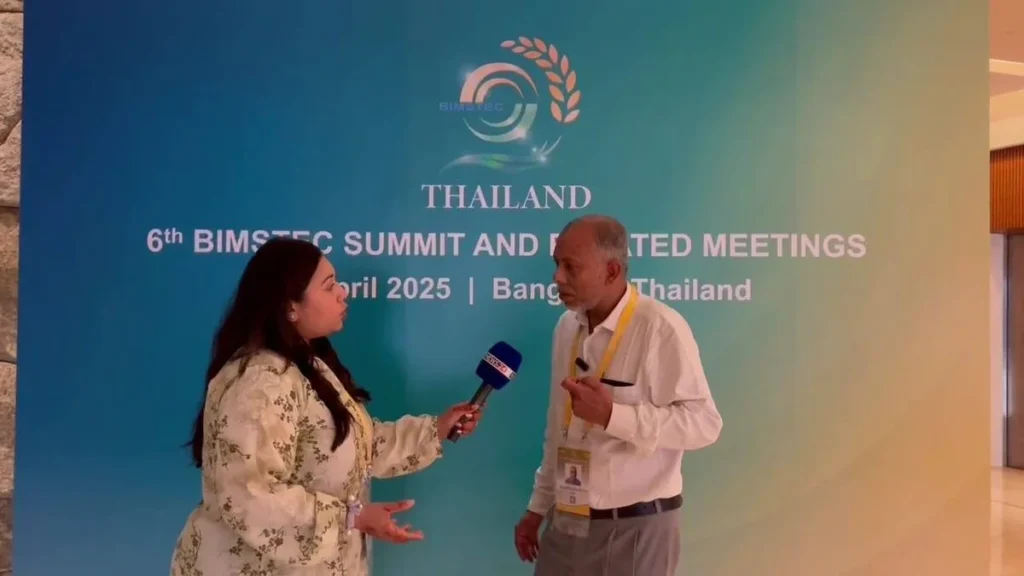A Historic Moment in Journalism
BANGKOK, Thailand: As world leaders gathered at the BIMSTEC Summit in Bangkok earlier this month, one journalist stood out in the crowded press room: Milan Bahadur Chettri, the first Indian Nepali-speaking reporter ever accredited to cover the high-profile diplomatic event. His presence wasn’t just a personal milestone but a turning point for multilingual journalism in South Asia 5.
Chettri, a seasoned journalist with a track record of covering nine major global summits, including the G20 and BRICS, brought a unique perspective to the summit. Fluent in Nepali, a language spoken by over 19 million people, he bridged gaps between Indian diplomacy and Nepal’s media landscape, offering insights often missed by the English-dominated press corps 5.

The Man Behind the Milestone
Chettri’s journey to BIMSTEC began in India’s northeastern Sikkim, where he grew up in a multilingual environment. His fluency in Nepali, Hindi, and English became an asset as he carved a niche in international reporting. Before BIMSTEC, he had already covered the 2024 BRICS Summit in Russia, the G20 in Brazil, and COP30 in Azerbaijan, a rare feat for any journalist, let alone one representing a regional language 5.
Securing accreditation for BIMSTEC wasn’t easy. “Many assume global summits are only for English or French speakers,” Chettri noted in an interview. “But diplomacy happens in many languages. My accreditation proves that.” His persistence paid off when he became the only Indian Nepali-speaking journalist to join the summit’s official press pool 5.
Why Nepali Matters in Diplomacy
The BIMSTEC Summit, which includes countries like India, Nepal, Thailand, and Myanmar, often hinges on nuanced cross-border discussions. Chettri’s language skills allowed him to secure exclusive interviews with the Presidents of the Chambers of Commerce of Thailand and Nepal. These conversations delved into trade ties often overlooked by mainstream media 5.
“English summaries can’t capture every detail,” explained a Nepali delegate. “When Milan interviewed us in Nepali, we could speak freely about sensitive issues, like India’s ‘Burma Mission‘ after Myanmar’s earthquake.” Chettri’s reporting highlighted India’s $50 million aid package and its role as a regional leader in disaster response, a story he later shared with Nepali-language outlets, reaching audiences often excluded from global news 5.
BIMSTEC 2025: Crisis and Cooperation
This year’s summit was dominated by Myanmar’s catastrophic earthquake, which killed over 10,000 people and displaced millions. India’s rapid deployment of medical teams and relief supplies under the “Burma Mission“ became a key talking point. Chettri’s coverage showcased how regional alliances like BIMSTEC can pivot during crises, a narrative he amplified through his bilingual reporting 5.
Prime Minister Narendra Modi’s speech at the summit reinforced India’s commitment to “neighborhood-first“ diplomacy. Chettri’s ability to translate Modi’s Hindi address into Nepali for Himalayan audiences ensured the message resonated beyond English-speaking elites 5.
Behind the Scenes: The Grind of Summit Journalism
Covering a global summit isn’t glamorous. Chettri spent 16-hour days juggling press briefings, interviews, and deadlines. “You sprint between venues, fight for Wi-Fi, and sometimes miss meals,“ he admitted. His advantage? Pre-summit prep: studying past BIMSTEC agreements, networking with delegates, and even rehearsing questions in Nepali 5.
His biggest coup? Landing a one-on-one with Thailand’s Chamber of Commerce President after a formal Q&A session ended. “I asked in Nepali if he’d consider investing in India’s northeast. That surprised him, and got me an extra 10 minutes,“ Chettri recalled. The resulting article revealed untapped trade potential between Thailand and India’s Himalayan regions 5.
What Chettri’s Success Means for Journalism
Chettri’s breakthrough underscores a global shift toward inclusive media. According to a 2024 Reuters Institute study, only 12% of international summit reporters come from non-English backgrounds. His work challenges that imbalance, proving regional languages can elevate diplomatic coverage 5.
“News isn’t just for elites,“ said a media analyst. “When a farmer in Nepal reads about BIMSTEC in their language, that’s real impact.” Chettri’s following assignments, the G7 in Canada and COP30 in Brazil, will further test this model 5.
The Road Ahead
Chettri’s BIMSTEC feat is just the start. With accreditation pending for the 2025 G7 Summit in Canada, he aims to spotlight Indigenous and Nepali diaspora issues, topics rarely covered in mainstream summit reporting. “If I can ask a question in Nepali to Canada’s PM, that’s a win,“ he said 15.
His advice for aspiring journalists is simple: “Your language isn’t a barrier, it’s your microphone.”










